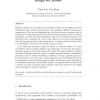Free Online Productivity Tools
i2Speak
i2Symbol
i2OCR
iTex2Img
iWeb2Print
iWeb2Shot
i2Type
iPdf2Split
iPdf2Merge
i2Bopomofo
i2Arabic
i2Style
i2Image
i2PDF
iLatex2Rtf
Sci2ools
ISCI
2008
2008
Attribute reduction in decision-theoretic rough set models
Rough set theory can be applied to rule induction. There are two different types of classification rules, positive and boundary rules, leading to different decisions and consequences. They can be distinguished not only from the syntax measures such as confidence, coverage and generality, but also the semantic measures such as decisionmonotocity, cost and risk. The classification rules can be evaluated locally for each individual rule, or globally for a set of rules. Both the two types of classification rules can be generated from, and interpreted by, a decision-theoretic model, which is a probabilistic extension of the Pawlak rough set model. As an important concept of rough set theory, an attribute reduct is a subset of attributes that are jointly sufficient and individually necessary for preserving a particular property of the given information table. This paper addresses attribute reduction in decision-theoretic rough set models regarding different classification properties, such a...
| Added | 12 Dec 2010 |
| Updated | 12 Dec 2010 |
| Type | Journal |
| Year | 2008 |
| Where | ISCI |
| Authors | Yiyu Yao, Yan Zhao |
Comments (0)

